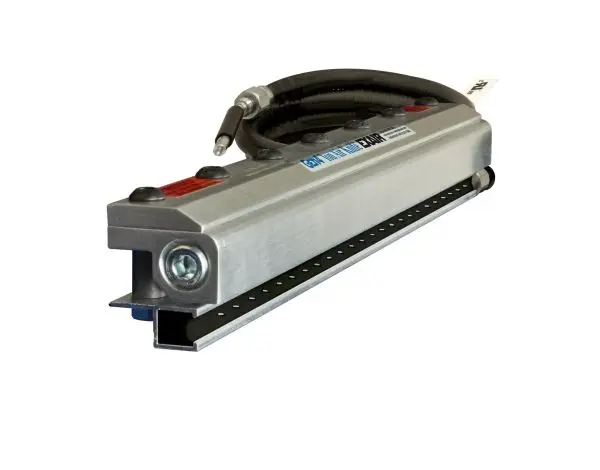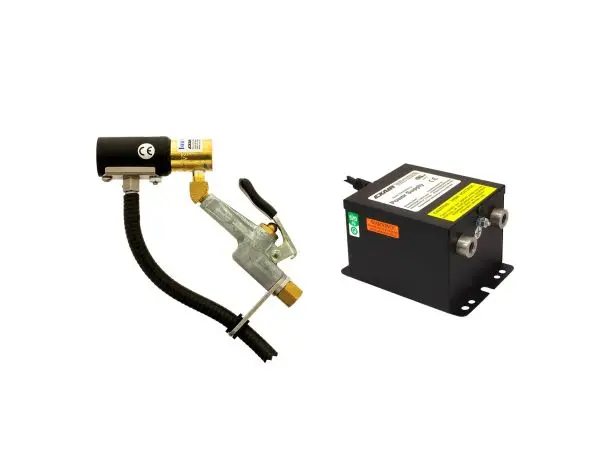The removal of static from surfaces and products can be important in many production settings. Static charge can attract dust and impede successful product cleaning.
One method of static reduction is to use ionised air stream to eliminate the built-up charge. The basic operating principle is that an air stream is passed through an ionising strip. The strip as an high voltage alternating current which either strips electrons from the passing molecules or gives additional electrons to them depending on which part of the AC cycle it is on. In this way the air stream now consists of both positive and negative ions.
When this ionised air hits a charged surface one set of ions will be deflected as like charges repel each other but the oppositely charged ions will be attracted. When they come into contact with the surface the ions with either release or absorb an electron and become a normal air molecule. In this way, regardless of whether the static is positive or negative in nature, it will be removed by the ionised air stream.
All ionised air static control products rely on the air being delivered to the target that needs treating. As such the addition of ionising strips to our compressed air enhancement product lines make a lot of sense. The static removal effects of ionised air streams can be an application in its own right or can be combined with an air blow off, drying or cooling function.
Engineering Considerations
Air Blow-off Performance
If air blow off is also required then the normal considerations that affect this application need to be taken into account. Essentially a product that produces the correct distribution and air force will need to be deployed along with an integrated ionising strip. The presence of the ionising strip will make no practical difference to the air blow off application and the fact that the air flow consists of partly ionised air molecules will, again, make no difference to the force of the air delivered to the target per se.
Where a difference may be seen is in how effective that air blow off force is. If static is helping to bond product, debris or dust to the target then the reduction in static will make air blow off easier to achieve. In such situation ionising air knives or air edgers will out-perform standard products by virtue of the fact that the debris being remove is less statically attracted to the surface. So, the same air consumption will clean better and will also leave the target static free.
Advantages of Laminar Flow
As the ionising strips produce both negative and positive ions they will naturally recombine over time. The more the cations (positively charged ions) and anions (negatively charged ions) mix the faster this recombination will be. Obviously recombined ions are no longer ions and so will have no static reducing effect.
One distinct advantage of many compressed air enhancement devices is that they produce rapidly moving laminar flows of air. A laminar flow is non-turbulence and so the air within it does not mix around so much. This means that the air streams from air knives and air edger’s fitted with ionising strips will retain their static removal properties for a greater distance from the air outlet than traditional bowers. This feature has some obvious practical advantages when it comes to positioning i.e. an air knife ioniser could be positioned further from the target than a blower ioniser and still delivery effective static reduction.
Some manufacturers make claims of effective static reduction at distances of 6m from the air knife ioniser. This is, in our experience, probably not advisable but certainly distances of 2-3 meters will still deliver fairly good ionised air flows where as a comparable non-laminar blower system would barely deliver any static reduction at the same distance.
The general rule of thumb is that if the factory layout means that ionising blowers cannot be places close to the target (within a meter) then it may be advisable to look at laminar flow alternative. The laminar flows will mean more ions reach the target so more static will be eliminated per kV of power used. As the voltages of ionising bars are quite high this can save considerable money in the long run.
Maintenance and Reliability
There are two elements to the static control products on offer from the Air Nozzle People. The first element is ioniser. This requires a relatively high AC power supply to strip or apply electrons to the air molecules. The second is the air moving element itself this can either be in the form of an integrated electrically powered blower or by combining the ioniser with a compressed air enhancement device, in which case the air moving element is powered only by the air pressure.
Compressed air enhancement devices
When compared to other air movement systems compressed air systems are very easy to maintain and install. As there is no power source other than the compressed air line itself there is very little to go wrong with the system or to install other than the air line itself. Many factory settings will have compressed air lines already near where there are needed anyway.
Often static control systems are needed in the area of the factory that is not well suited to installing electrically powered conveyor systems. With conventional, electrically powered systems great thought will need to be given to protecting the system from dust or fluid contamination. In dusty, wet, dirty or humid conditions the fact that compressed air systems need no other power source can be a huge advantage in terms of reliability.
The ionising bars themselves require power but do not have mechanical moving parts so will generally be less prone to break down than mechanical devices operating in dirty environments. That being said careful consideration needs to be given to the reliability of any electrically powered device operating in moist, dirty or dusty conditions.
Ionisers
The ionising bar itself requires a high voltage AC current to operate. A minimum of 3.6kV is required for basic ionisation and the level of ionisation increases with voltage. All our ionising bars are powered by large 7kV suppliers so they give excellent levels of ionisation. Power supplies degrade over time so it is important to have enough degradation room so that ionisation will still occur even after a period of continual use. It is also vital that the power supply itself is maintainable and repairable. Naturally all our power supplies are fully repairable and so the same unit, maintained properly can last many years. Cheaper power supplies will need to be fully replaced on a fairly regular basis meaning they are more costly in the long run and will result in more factory down time.


